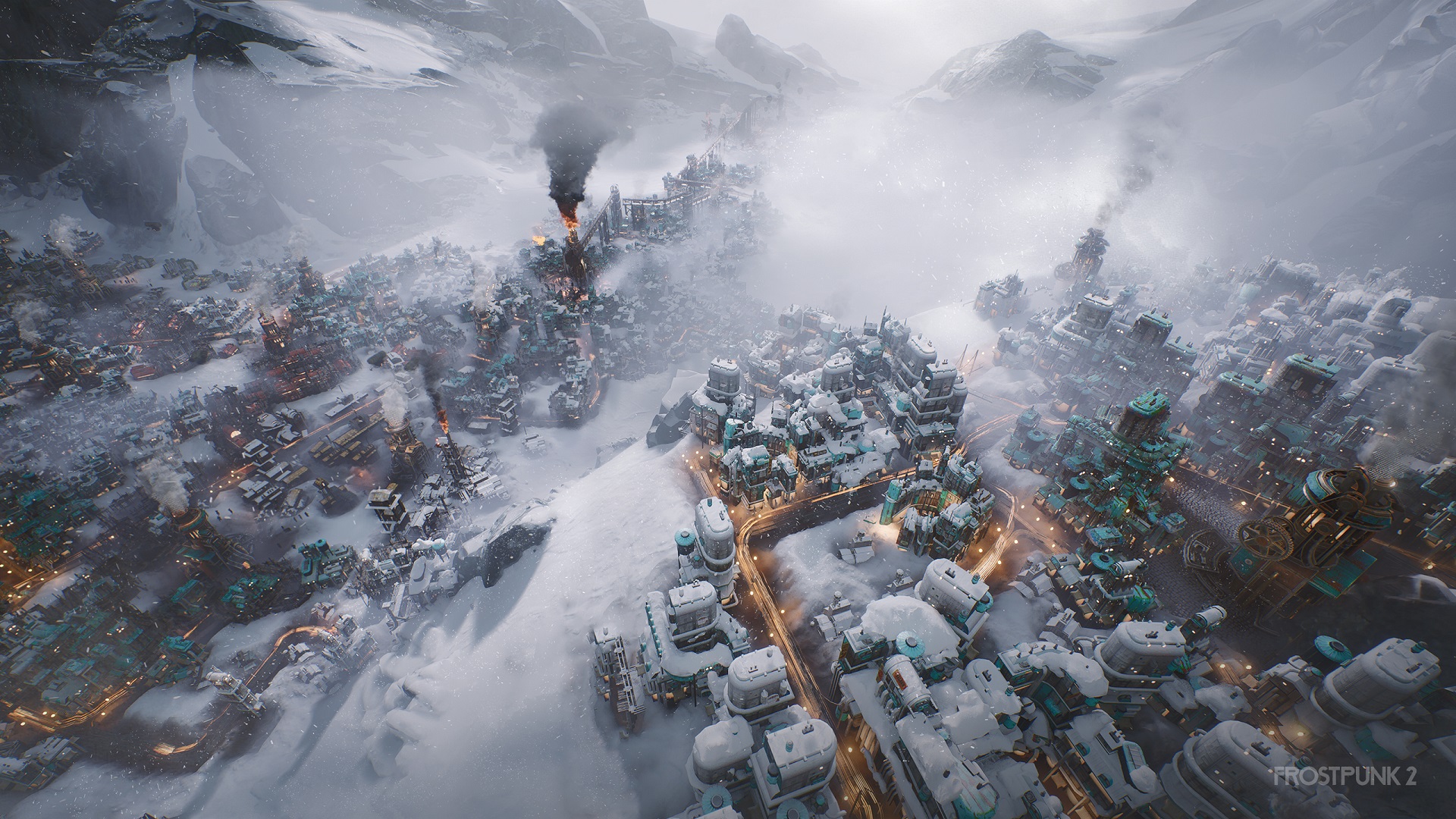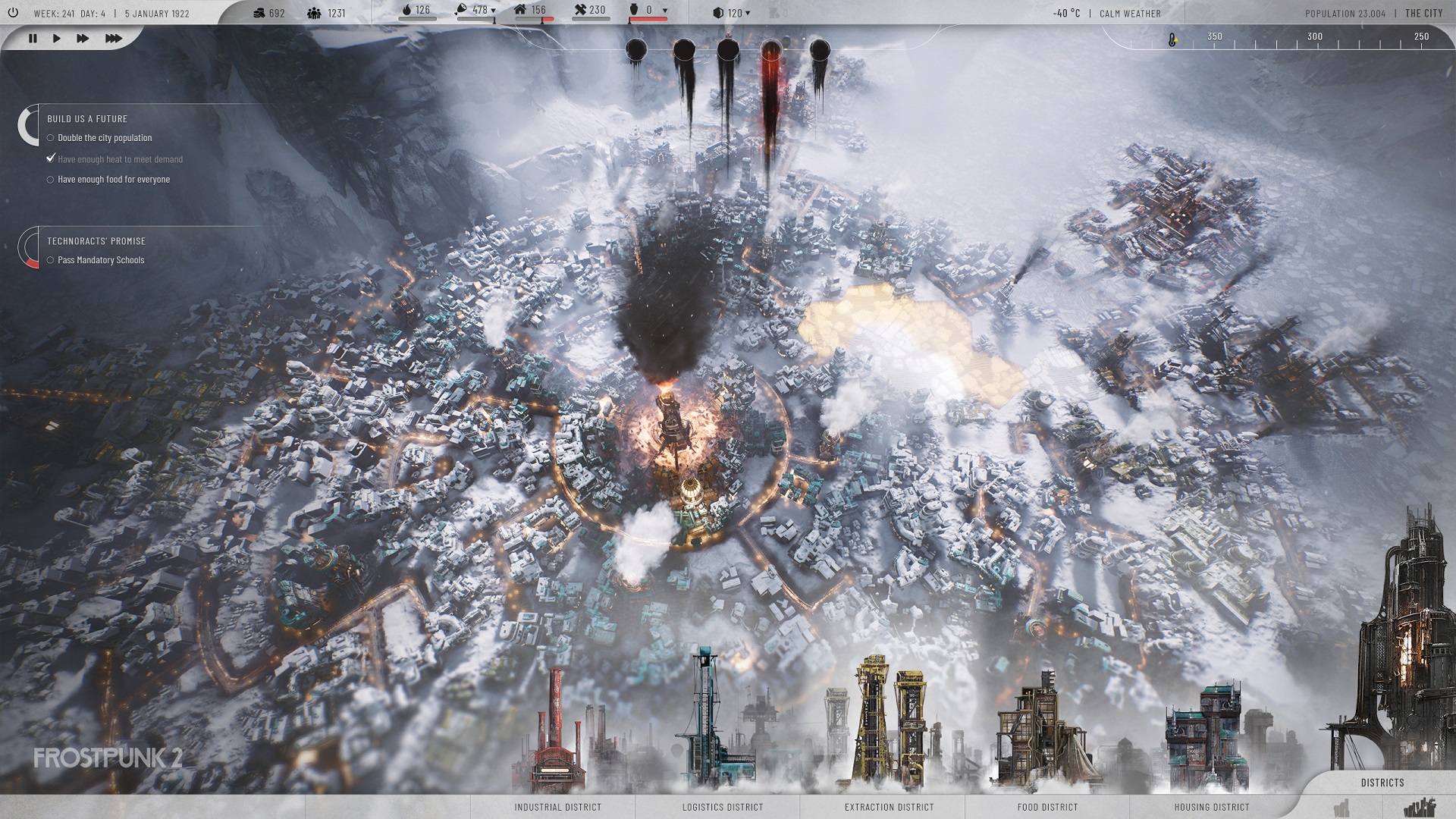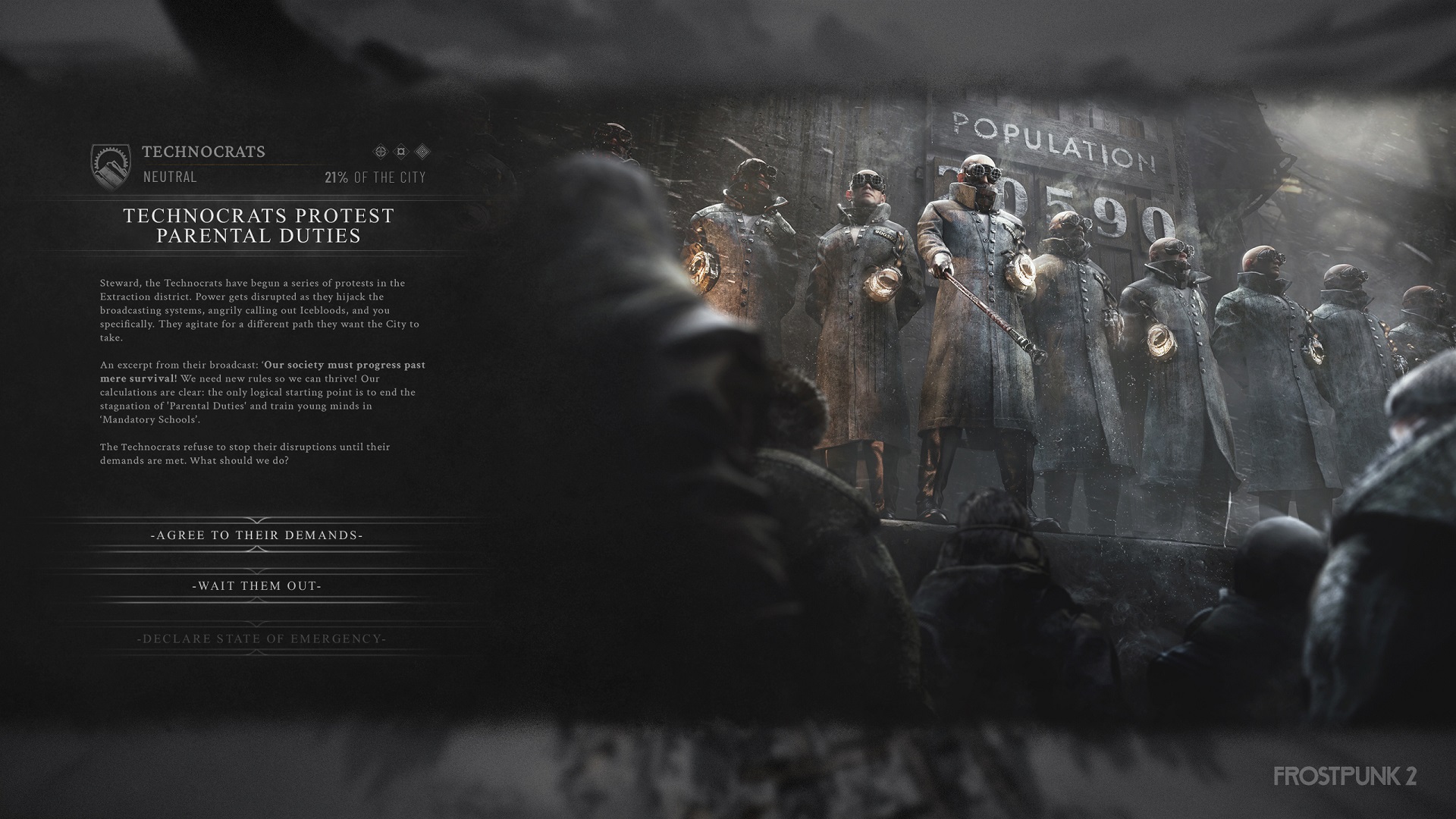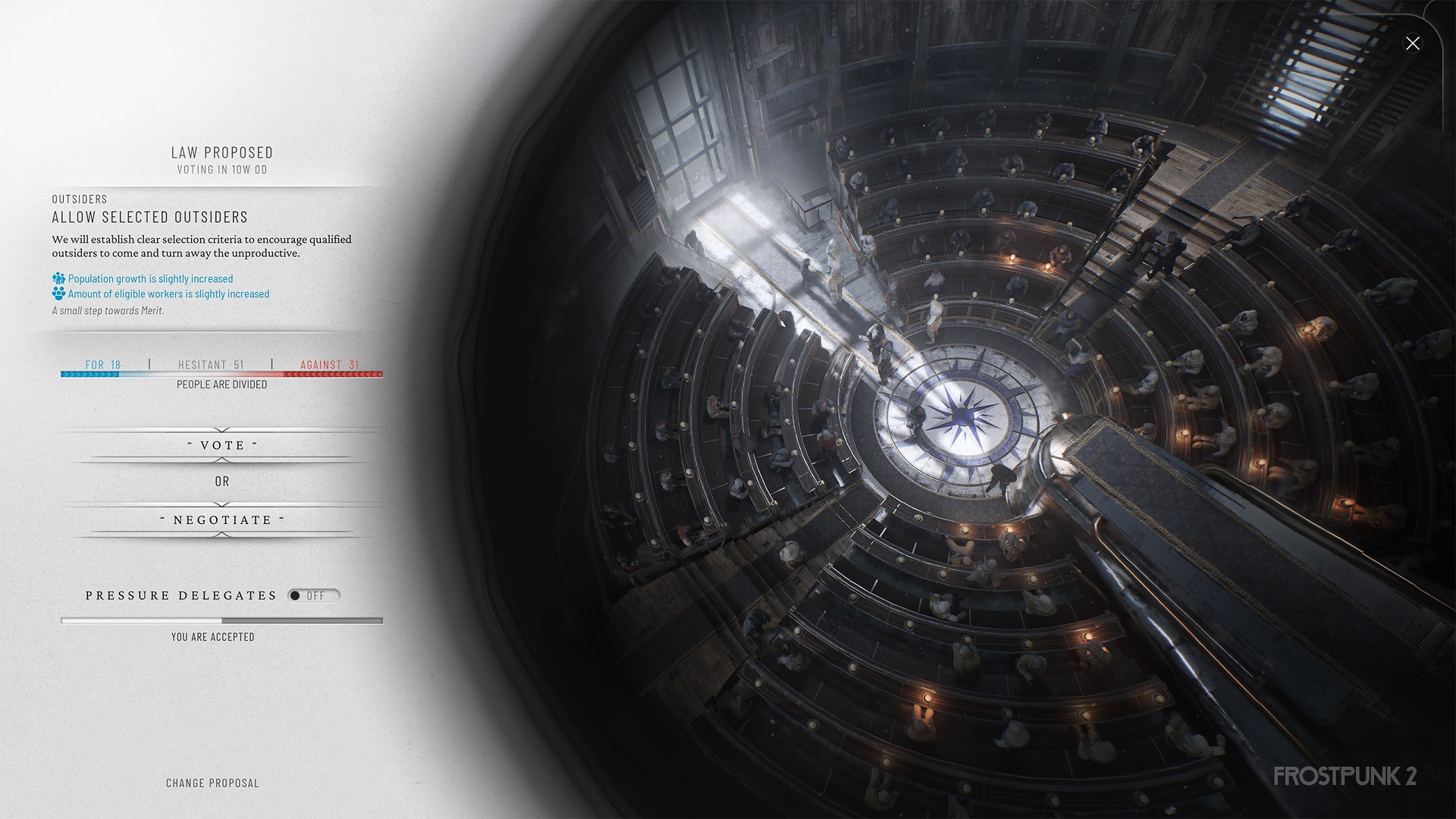Frostpunk was about surviving the end of the world – Frostpunk 2 is about rebuilding its future
Preview | Frostpunk 2's evolved social system looks set to bring added depth to the survival city-builder experience

I can still remember the feeling of playing Frostpunk for the first time. The beginning throws you right into the biting cold of a desolate, snowy landscape. Coal is an invaluable resource, and getting lots of it early on is integral to your citizen's survival. Within the first hour, you face food shortages, the dangers of frostbite, and a desperate need to begin researching advancements to help your generator produce steam and, more importantly, heat. Everything is a fine balance between life and death, from the laws you choose to enact that can please or upset your people, and even lead to some pretty dire consequences, to the decisions you make when it comes to resource gathering and what you build. The pressure is on from the get-go as you try to survive as the last city on earth. While it's undoubtedly challenging, Frostpunk held so much appeal thanks to its exploration of human nature and the many difficult choices it presents.
When I sat down to check out a hands-off demo of Frostpunk 2, I was immediately curious to see how the follow-up has built on what came before, and what it's doing differently. With co-director and design director Lukasz Juszczyk and game and art director Jakub Stokalskia as my guides, I took a look at Frostpunk 2's Utopia builder, which is the game's take on a sandbox mode that shares some similarities with the endless mode in the first game. It's immediately apparent that much has been expanded upon, from the threats you can face to the mechanics and features you can use. In fact, as Stokalskia points out, what I see Juszczyk start to build up is a central district that's already roughly the size of a whole city you'd have at the end of a full playthrough of Frostpunk 1.
What's most exciting, though, is what the team at 11 Bit Studios has done when it comes to the evolution of the social system. Set 30 years after the blizzard storm that led to catastrophe, times have changed, and your city is home to a growing community that sees the rise of different factions. These factions each have their own set of values and beliefs that factor into the laws you try to pass and what decisions you make as you try to shape your own utopia. Where Frostpunk had us trying to survive the end of the world, Frostpunk 2 instead poses the question: how do you create a brighter future for the people after the apocalypse?
Balancing act

While you can expect to dive into a core scenario campaign just like the first game, the sandbox Utopia mode allows me to get a good look at some of the new systems and features in Frostpunk 2. Just like before, you'll be up against the harsh, cold environment you may have tried to tackle with steam if you played the original experience, and resource management is still very much a balancing act. But now we can plan out a metropolis made up of different districts across the snowy landscape that serve different functions.
"To tell a tale of this scale, we really need a change of scale, which is not only present on the physical layer here, but we tried to adapt all of the different mechanics here to support the story we're telling. And this goes for instance, for construction mechanics," Stokalskia explains. "What Lukasz is doing, he's not building buildings and placing tents anymore, we're actually expanding the city by planning out districts, which perform different functions. So we need an extraction district to get coal for our generator, for example, and we need housing to provide shelter for people."
"The basic economy of the city is really built around supply and demand systems, every district that you build will provide something to the city, but at the same time, it will constantly demand a certain level of resources to keep operating on a good enough level, and you obviously need a workforce to maintain it. But also things like, heat for instance, to keep everyone warm. So the more districts we build, the more capabilities we have. But at the same time, the bigger demands we have for different types of resources. And this balancing act is at the heart of the basic economy."
Just like the first game, you can still "mismanage yourself into oblivion" as you try to survive the environment and build out your city more and more, as Stokalskia jokes, but the expanded size opens up the way to new problems to confront, and added depth to the building and survival side of the experience.
Weekly digests, tales from the communities you love, and more
Factions

But the scope isn't just felt in terms of the scale of the city you can create and shape in Frostpunk 2. The buildings themselves still have specific functions in the districts, with Stokalskia and Juszczyk showing me the Research Institute, a special building that gives you access to a system known as the "idea tree". This allows you to explore different ideas that are presented as a challenge or a problem to address in order to further develop the city. How you choose to resolve it will depend on who you ask in the city – which is home to different community factions that will weigh in with their ideas and approaches.
The factions also play into one of the most exciting new features I got to see, which was the Council hall. While the first game had you pass laws in the name of survival, Frostpunk 2 sees the people of the city have more involvement and say in the laws you pass. The Council is where you try to enact laws on different issues that arise, but you do so by calling for a vote from 100 delegates that are divided between factions.
You can also directly speak with them to see their views on the matter at hand, which brings added dimension to the social system. Now you can clearly see the social divides, which presents new challenges within the walls of your city. During the session, I'm shown an example of a law that can be passed to determine the place children should have in the city – whether that be at workhouses, at school, or at home, for example. I then got to see four factions, including The Engineers, Foragers, Icebloods, and Technocrats, who all hold their own principles and have something different to say. How they vote depends on what you decide, but you need to have a certain amount of votes to successfully get your way.

"Whether you build a building, whatever choice you made in difficult situations, and definitely whichever law you decided to pass, all of this will shape the zeitgeist of your city," Stokalskia says. "It will accumulate into a set of choices that may put your city in a consistently enough place that maybe you find yourself governed by adaptation; you consistently value this over other solutions to problems. Maybe you actually brute force with technology the challenges presented by nature, so that everyone can prosper. Or you solve social problems through logical reasoning. But what you can definitely count on is that your communities will react to whatever Zeitgeist you end up shaping."
Frostpunk 2 certainly doesn't shy away from giving you hard choices to make, not unlike the first game, but I love the way the Council system brings the city together in a new way to help shape the future you're striving for. It's clear that so much thought has been put into the follow-up, with an expanded scope, noticeable changes, and new features that the team hopes newcomers and fans alike can enjoy when it arrives in 2024.
"This is something we feel we couldn't have done differently in the sense that we really did not want to do more of the same," Stokalskia says of the approach to Frostpunk 2. "Ultimately, we don't really believe that would be really that satisfying to the fan base either. Because they've played Frostpunk, and there's a lot of Frostpunk to still play right. We're really more interested in adding to the world and adding to the experience rather than rehashing what was."
Frostpunk 2 is set to release sometime in 2024 on PC. See what else is ahead with our roundup of new games for 2023 and beyond.

I started out writing for the games section of a student-run website as an undergrad, and continued to write about games in my free time during retail and temp jobs for a number of years. Eventually, I earned an MA in magazine journalism at Cardiff University, and soon after got my first official role in the industry as a content editor for Stuff magazine. After writing about all things tech and games-related, I then did a brief stint as a freelancer before I landed my role as a staff writer here at GamesRadar+. Now I get to write features, previews, and reviews, and when I'm not doing that, you can usually find me lost in any one of the Dragon Age or Mass Effect games, tucking into another delightful indie, or drinking far too much tea for my own good.



